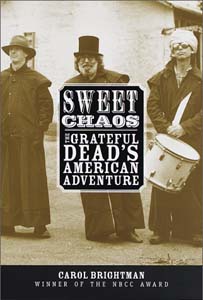![[Metroactive Books]](/books/gifs/books468.gif)
[ Books Index | Metro | Metroactive Central | Archives ]
Raising the Dead
'Sweet Chaos' traces the strange history of the Grateful Dead
By Jeff Kearns
HOW DID A jug band from Palo Alto turn into a religion? Carol Brightman, who was never a Deadhead, was in a better position than almost anyone to tackle the enigma--specifically, in the lighting booth. In Sweet Chaos: The Grateful Dead's American Adventure, Brightman takes a unique wide-angle portrait of the band, but the band itself is only part of the story.
In addition to providing a deeply researched history of the Dead, Brightman includes her own history as an anti-war activist during Vietnam and her sister Candace Brightman's life with the group, which began in 1972, when she signed on as the Grateful Dead's lighting designer.
Sweet Chaos begins in the sweet, chaotic pre-Dead days, with Mother McCree's Uptown Jug Champions playing bluegrass in the druggy intellectual scene around Stanford in the early '60s, then zapping synapses at the Acid Tests as the Warlocks, and their birth as the Grateful Dead in the psychedelic days of the Haight-Ashbury.
Brightman chronicles how the obsession of Jerry Garcia and songwriter Robert Hunter with traditional American musical forms like folk, bluegrass, blues and country later gave way to trippy electric rock influenced by jazz. And in the early '70s, how the Dead merged the seemingly schizophrenic sides of their own background and of American music in general into the sound that stayed with the band until the end.
But Brightman also goes out of her way to include her own years cutting sugar cane in Cuba, the CIA's constant covert meddling in the American drug scene and the anti-war movement, with which the Dead never wanted to become involved.
The book gets at the mystery of why the Dead became legends while other '60s bands faded into obscurity: mainly, because they weren't a '60s band. While other bands demanded an end to the war and a laundry list of diverse political requests, the Dead never dirtied their hands with politics and barely talked to the audience at all in later years. And audiences never saw standard rock high jinx, like crazy costumes or guitar-smashing. As Brightman notes, "The Dead's aesthetic was to avoid showmanship ... never to be an act."
What about Deadheads? The culture that formed around the band did so on the road, where the motifs of home and away found in the songs were mirrored in the lives of the most dedicated Deadheads. "Scanning the lyrics, one is struck by how finely attuned they are to the fears and hopes of adolescence," Brightman writes. "For many, the music and the crowds were/are stations of the cross of growing up absurd in America."
Brightman occasionally sat up in the lighting booth with her sister at various times over 23 years, but she never became one of the followers. Brightman doesn't butter up the band with gee-whiz sycophancy. The band's foibles are also detailed, including the nights when the music was just plain bad, the musical shortcomings of some band members, the chemical dependency of others and the band's indifference to its own fans.
Brightman conducted about 100 interviews for the book but passed up one: Garcia. Even though Brightman began the book before the guitarist's death in 1995, she didn't approach him. He's still in there, although subdued and isolated. In the last years, even as the Dead were one of the top-grossing bands in the country, the joy of it seemed gone for Garcia, and he's remembered as miserable, constantly tired and isolated by the cultish following he never asked for. By painting the band on such a large canvas, we see it not only as an essential part of American musical history but also as an important player in the history of the Bay Area.
There's an impressive supporting cast, too: Bill Graham, Robert Hunter, John Perry Barlow, Ken Kesey, Stewart Brand, Neal Cassady, Mountain Girl, Allen Ginsburg, Jerry Rubin, Mario Savio and others appear in the pages, including Fidel Castro himself. The result is a book that's as good for the uninitiated as it is for those with dozens of tapes labeled only with a city and a date.
[ San Jose | Metroactive Central | Archives ]
Copyright © Metro Publishing Inc. Maintained by Boulevards New Media.
![]()
 More Than a '60s Band: The Dead transcended the psychedelic era.
More Than a '60s Band: The Dead transcended the psychedelic era.
Sweet Chaos: The Grateful Dead's American Adventure by Carol Brightman; Clarkson Potter Publishers; 356 pages; $27.50 cloth.
From the April 15-21, 1999 issue of Metro.